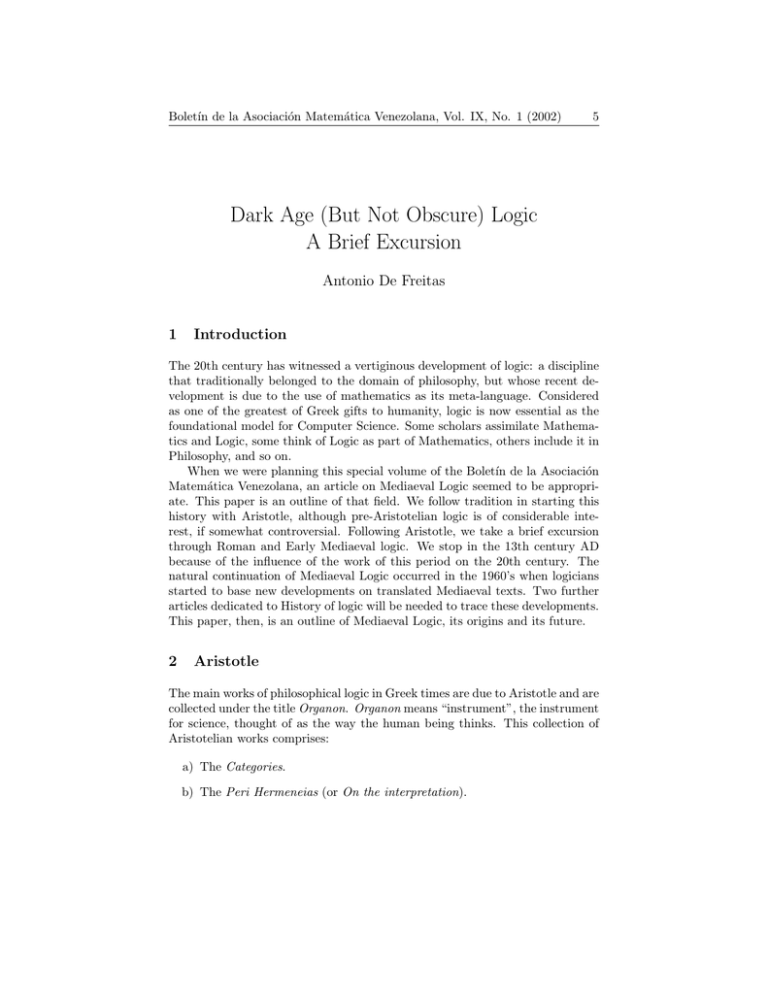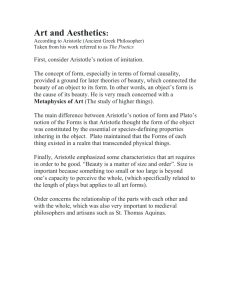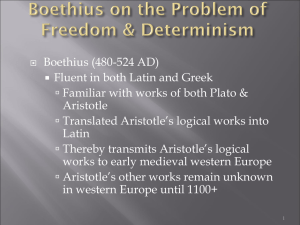Dark Age (But Not Obscure) Logic A Brief Excursion Antonio De Freitas 1
advertisement

Boletı́n de la Asociación Matemática Venezolana, Vol. IX, No. 1 (2002) 5 Dark Age (But Not Obscure) Logic A Brief Excursion Antonio De Freitas 1 Introduction The 20th century has witnessed a vertiginous development of logic: a discipline that traditionally belonged to the domain of philosophy, but whose recent development is due to the use of mathematics as its meta-language. Considered as one of the greatest of Greek gifts to humanity, logic is now essential as the foundational model for Computer Science. Some scholars assimilate Mathematics and Logic, some think of Logic as part of Mathematics, others include it in Philosophy, and so on. When we were planning this special volume of the Boletı́n de la Asociación Matemática Venezolana, an article on Mediaeval Logic seemed to be appropriate. This paper is an outline of that field. We follow tradition in starting this history with Aristotle, although pre-Aristotelian logic is of considerable interest, if somewhat controversial. Following Aristotle, we take a brief excursion through Roman and Early Mediaeval logic. We stop in the 13th century AD because of the influence of the work of this period on the 20th century. The natural continuation of Mediaeval Logic occurred in the 1960’s when logicians started to base new developments on translated Mediaeval texts. Two further articles dedicated to History of logic will be needed to trace these developments. This paper, then, is an outline of Mediaeval Logic, its origins and its future. 2 Aristotle The main works of philosophical logic in Greek times are due to Aristotle and are collected under the title Organon. Organon means “instrument”, the instrument for science, thought of as the way the human being thinks. This collection of Aristotelian works comprises: a) The Categories. b) The Peri Hermeneias (or On the interpretation). 6 A. De Freitas c) Prior Analitics. d) Posterior Analitics. e) Sophisticis Elenchis (or On Sophistical Refutations). f) The Topics. The word “logic” took its modern signification only in about the third century AD. The treatises collected by Aristotle’s disciples were related to the capacity of reasoning. Many Aristotelian works look like notes or guidelines for oral expositions, and it seems that Aristotle did many reviews of each work, inserting cross-references to works written later. Most scholars agree that the first eight chapters of the Categories are the starting point of those works. The doctrines included appear as integrated parts of all the other treatises of the series. In this work, Aristotle offer us a classification of the predicates, listed under: the substance, the quantity, the quality, the relation, the place, the time, the situation, the state or condition, the action, and the passion. Written in the same period, the Topics, with its appendix De Sophisticis Elenchis, should be included here because it is related with dialectical reasoning, i.e. reasoning based on disputation and commonly accepted opinions, as opposed to demonstrative reasoning, that is based on true premises. The other contemporary work is the treatise On the Interpretations, or Peri Hermeneias. Its focuses on the many varieties of contraposition between couples of propositions. This treatise has a brief introduction to the philosophy of logic, discussing the notion of “enunciate”. Finally, the most mature works of Aristotle are the Prior Analytics, former devoted to the syllogism and its moods, and the Posterior Analytics, on the theory of demonstration, which are the main contribution of Aristotle to Logic. This has been merely a general and very wide approximation to the content of the Organon. In the Peri Hermeneias, Aristotle examined the conception of “the true”, starting with the Platonic theory developed in the Sophist. He developed a theory of signification and truth, discussing the relation between signification, temporality and truth, basically related with the verb “to be”. He makes a distinction between its copulative and essential uses, and addresses what we would today call “omnitemporality”. Furthermore, a non-well structured theory of modal logic might be based on chapters eight to seventeen of the Posterior Analytics. The importance of Aristotle in the development of the Logic is so substantial that many other thinkers fade in comparison. 3 The Megarics and the Stoics In ancient history, there were two great schools: the peripatetics, a heritage from Aristotle, and the stoics, developed by Crisip on the base of the megarics. Dark Age (but not obscure) logic 7 The main difference between the two schools was their starting point. While geometrical reasoning stimulated Aristotelian logic, megaric logic concentrated on zenonian dialectic and argumentative diatribes from common life, which Aristotle and Plato called “eristic”. In fact, stoic logic was known in ancient times as “dialectics”. Euclid founded the Megaric School and his disciples, such as Eubulid and Estilpon, discovered many paradoxes. We owe to the megarics the founding and formulation of certain interesting paradoxes and the reconsideration of the most relevant notions of modal logic. The megarics classified the paradoxes as follows: 1. The liar paradox: A man says that he is lying. Is this affirmation true or false? 2. The Electra paradox: You say that you know your brother. But the man that arrived with his head hidden was your brother and you didn’t give evidence that you know him. 3. The bald man: Would you said that a man with only one hair is bald? Yes. Would you say that a man with two hairs is bald? Yes. Would you say that. . . ? etc. Then where you put the border between a bald man and a non- bald man. 4. The horned man: What you haven’t lost, you have. But you haven’t lost horns; therefore you have horns. The first paradox shows us the kind of proposition that affirms both the true and falsity of the same proposition. It is the problem of the self-reference. The second offers us the problem of the different meanings of the verb “to know”, and the problem related with the identity of the subjects involved in an affirmation. The third is related with the vagueness of most of our current expressions. The last one shows us that when a proposition involves a presumption, either affirmation or negation may be valid, depending on certain restrictions. The stoics were the first to elaborate a complete theory of argumentation. They also seem to have made a complete study of the modal expressions related with “possibility” and “necessity”, if we can trust in the affirmation of many other authors. The word dialectics used by the stoics, which corresponds to our “logic”, is related to language; they were the first scholars to make a complete study of grammar. For the stoics, dialectics comprised what we think of as logic, linguistics and grammar, and perhaps some parts of rhetoric. They developed a theory of signification and they studied the relationship between the words of speech and the world. We can see as a theory, or a philosophy, of language. They made a distinction among: voice (vox), that could be a simple sound, noise; lexis, or signifying voice; and logos, or speech that has a proper signification. 8 A. De Freitas The main difference between the peripatetics and the stoics is that the former saw logic as an instrument and the latter as a part of philosophy. 4 Roman Logic Between the two last centuries BC and the first century AD, the proliferation of many different schools of logic and the confusion between the peripatetics and stoics produced a period in which there were no new developments in logic. But we should mention three names from that period: Cicero, Porphyry and Boethius. Although Cicero didn’t gave us nothing new in logic, he offers us an organisation of what the stoics and the peripatetics said. He also gave us new Latin terms like propositio and complexio. The former signified to Cicero the “premise rector” in the argument. Through time, this term changed its meaning; today it signifies something simpler. The latter was the term Cicero used for our dilemma. In his works Topica and De Oratore, Cicero unites logic and rhetoric into one branch of knowledge. Those works had a great influence on the learning of logic for many centuries. An important commentary to Aristotle’s Categories, which was used for a long time as an introduction to it, was the Isagoge of Porphyry, who lived at the end of the third century AD. Boethius may be considered as the last logician of the Roman period and the first mediaeval logician. He was the main transmitter of classical logic to mediaeval times and this alone would justify the position that we give to him. He also classified the conditional propositions by the kind of consequentia involved. For Boethius, the truth of a conditional proposition could not involve a necessary connection, but only secundum accidens. The theory had considerable influence on the development of mediaeval logic. 5 Mediaeval Logic We can distinguish three distinct periods in mediaeval logic: the first between Boethius and the works of Peter Abelardus; the second, the 13th century summulists, including Peter of Spain, William of Sherwood and Lambert D’Auxerre; and the third, 14th century logic, which includes Paul of Venice, Jean Buridain and William of Ockham. The important Ars Combinatoria of Raimundus Llul, a Catalan logician living in the 13th century, will not be discussed here, as it is the subject of a forthcoming article. The first period of mediaeval logic was based in the Categories and Topics of Aristotle and on the Isagoge of Porphyry, as we will see in the next section. After the rediscovery of the Sophisticis Elenchi, terministic logic began. Its main object of study was terms as parts of the speech in natural language Dark Age (but not obscure) logic 9 (particularly Latin). This logic maybe considered in two periods, differentiated by the development of the Theory of Supposition. 5.1 From Boethius to Abelardus Until the 12th century, the only generally available Aristotelian works were The Categories and the Peri Hermeneias, which were normally accompanied by Porphyry’s Isagoge and the logical treatises of Boethius. This set of works was ideal for people working in logic, because some Pseudo-Aristotelian works, and Arabic and Latin translations of spurious authority, including some commentaries, that normally induced mistakes and misinterpretations, were also in circulation. The first mediaeval logical treatise, due to Alcuin, was probably used in the study of the trivium, that Alcuin restored when he was nominated for the direction of the Palatine School by Charles the Great. The work focuses on the study of the Categories, with a lesser emphasis on the theory of argumentation. A misinterpretation and erroneous exposition of the logical treatises was written by Garland the Computist in Liege in the 11th century. The so called “ontological argument” of St. Anselm of Canterbury appeared in the Monologion, and it is possible to trace its development to St. Agustin of Hippona and to the stoics. Peter Abelardus was the most important logician of the called Logica vetus, i.e., the logic based only on the Categories, De Interpretatione, Porphyry’s Isagoge, and the Boethius’ logical treatises. The study of the problem of Universals was the main point of Abelardus’ logic, which was developed in four main works: 1. Introductiones Parvolorum: an explanation of the Aristotelian works and of Porphyry’s Isagoge. 2. Logica Ingredientibus: an enlargement of the previous work, with some elements of Boethius’ De Differentis Topicis. 3. Logica Nostrorum Pettitioni: an updated version of Porphyry’s Isagoge. 4. Dialectica: which includes commentaries on various works of Boethius. The most valuable are the Logica Ingredientibus and the Dialectica. A major part of Abelardus’ work is devoted to the study of the properties of the verb “to be”, as a copula, as an essential property, as a characteristic, etc. The great influence of Abelardus’ position on the categoric proposition is responsible for the development of the Theory of Supposition in the later centuries. In fact, the affirmation that a categoric proposition is true if and only if the subject-term and the predicated-term represent the same thing is the starting point for the studies of the 13th century summulists. 10 5.2 A. De Freitas Peter of Spain and his time One of the most important works on logic, which was widely distributed during the medieval age, was Petrus Hispanus’ Tractatus, an important contribution to European culture. In Paradise chapter XII of Divina Comedia, Dante Alighiere mentions Petrus Hispanus as the author of twelve books, and he is one of the few popes mentioned in this work. Dante’s son, in a later commentary on his father’s work, clarified that the twelve books are the Sumules Logicales, or the Tractatus as we now prefer to call them. Peter of Spain’s logical works have not been studied in depth, particularly as there is no total formalisation of his system. Some historical notes may be found in history of philosophy literature and some general articles about Petrus Hispanus refer to the Tractatus and the Syncategoreumata. There is an English translation of Tractatus with an introductory study of the philosophy of language by Dinneen. This is based on the Latin text fixed by L. M. De Rijk. An Italian translation from the 1940’s by Bochenski was based on only one manuscript. According to De Rijk, it is inadequate because it does not reflect the original text. The formalisation of the logical systems of the main summulists of the 13th century, i.e., Peter of Spain, William of Sherwood and Lambert D’Auxerre, would reveal the distinctive differences among them and establish the relationship between their logical works and our contemporary logic. The principal differences between continental and insular Logic in Europe were due to two main Logic textbooks: one by Peter of Spain (Petrus Hispanus) and the other by William of Sherwood. The former represents the Logic tradition of Paris and the latter that of Oxford, represented in the Logica cum sit nostra modus oxonii. The great diffusion of the Tractatus was due to the fact that most of the European Universities take it as compulsory Logic text. As a result, we have around 300 manuscripts of the Tractatus, 200 printed editions (until the 17th century) and ten incunabula. Some parts of the Tractatus were based on Aristotle’s Organon, Porphyry’s Isagoge and some of Boethius’ Logical treatises, but others are logical treatises on specific topics that were developed in the Middle Ages. For example, Tractatus XII, De distributionibus, is a compendium of medieval quantification theory, i.e., an analysis of the problems of the use of quantification and its relation to the syllogistic. The Syncategoreumatas is the second work of Peter of Spain. It contains some elements of great importance for the study of Medieval Logic. It focuses on the study of the syncategoreumas: terms of a proposition that have no significance outside it but give it logical value, and in that sense are responsible for the significance of the proposition to which they belong. Dark Age (but not obscure) logic 11 Nowadays there is considerable interest in the study of such syncategorematic words as the verb “to be”, as a copulative particle, the negation “no”, the conditional “if, . . . , then, . . . ”, etc. The Theory of Propietatis Terminorum tries to offer a characterisation of the function of each word as a part of the speech. One of the main theories of mediaeval logic is the Theory of Supposition and Signification, a kind of philosophy of language [De Freitas (1999)], that was treated from different points perspectives in the two periods we are considering. Supposition in the 13th century was thought of as non-contextual, but in the 14th century it was characterized as omnitemporal or atemporal. Of course, there were also differences among logicians in each period. For the summulists, like Peter of Spain, supposition is in general the subordination of one thought to another. For example, suppose that when I say “man”, I mean to refer to all men that were, are or will be. Then the word “man” is subordinated to the being man. Each logician had a different classification of supposition and there was much discussion about this point. Remember that the main interest of the mediaeval logicians was in natural language and the consideration that it could be a representation of the world. The theory of supposition and signification is analogous to the Frege’s theory of signification and sense. The 13th century logicians could be classified as realists, because they accepted that the general terms signified universals or characteristics that could be common to many things. In the 14th century, the paradigmatic figure is Ockham, who offered us a nominalist or conceptualist position. He thinks that the signs – natural or conventional – represent only singular things, because in the world there are not more things than can be signified. He takes as absurd the affirmation that a universal is something that exists in a plurality of individuals to which we apply a common term. He prefers to talk about concepts and not about words, because the concepts are the primary signs. This theory of signification and supposition in Ockham differs significantly from that proposed in the 13th century. 6 Post-Mediaeval logic The Tractatus of Peter of Spain was used as the statutary logical textbook in the main European Universities until 17th century. Most of the philosophical logic texts used in Universities today are still based upon the Peter of Spain heritage, either directly or via Pedro Da Fonseca’s Institutiones Dialecticarum libri octo, which was accepted as a substitute during the 14th century, in Coimbra, and was also widely used, as we can deduce from the fact that it was printed at least fifty-three times between 1564 and 1625. 12 7 A. De Freitas What more? During the discussion on the paper [De Freitas 1998] I delivered in the XI LatinAmerican Symposium in Mathematical Logic, Professor Ramon Pino, from the Informatic Group of the Universite of Lille, suggested that the Mediaeval theory I have presented could be relevant to Artificial Intelligence. That seductive suggestion led me to seek Computing applications for Mediaeval Logic. In further papers, I will explore and discuss: a formalization of Supposition Theory; Porphyry’s Tree and Ontologies; non-monotonic reasoning and syllogisms; and relevant logic and negation in Peter of Spain. The attached bibliography could serve as an appetizer to those interested in non-mathematical logic, who might discover that the logic made during the Dark Ages was more illuminating than that of the era of Positivism. Bibliografı́a Abranches, Casiano: Pedro Hispano e as “Summula Logicales”, Rev. Portuguesa de Filosofia, Tomo VIII, Fasc. 3, 1952, p. 243-259. Aristóteles: Metafı́sica, edición trilingue (griego, latı́n, español), Gredos, 1984. Aristotle: Categories. On Interpretations. Prior Analitics, Loeb Classical Library, Harvard University Press, 1996. Aristotle: On Sophistical Refutations. On Coming-to-be and PassingAway. On the cosmos, Loeb Classical Library, Harvard University Press, 1992. Aristotle: Posterior Analitics. Topica. Loeb Classical Library, Harvard University Press, 1997. Broadie, Alexander: Introduction to Medieval Logic, Clarendon Press, Oxford, 1993, 2nd edition. Bochenski, I. M.: Summulae Logicales, Domus Editorialis Marietti, 1947. De Rijk, L. M.: On the genuine text of Peter of Spain’s Summule Logicales, I: General Problems concerning Possible interpolations in the Manuscripts, in : Vivarium 6 (1968), p. 1-34. De Rijk, L. M.: On the life of Peter of Spain, The author of the Tractatus, called afterwards Summule Logicales, in: Vivarium 8 (1970), p. 123-154. De Rijk, L. M.: “Significatio” y “Suppositio” en Pedro Hispano, in: Pensamiento 25 (1969) p. 225-234. Dark Age (but not obscure) logic De Rijk, L. M.: Peter of Spain (Petrus Hispanus Portugalensis) Tractatus: called afterwards Summule Logicales. First critical edition from the manuscripts. Van Gorcum, Assen, 1972. De Rijk, L. M.: Syncategoremauta with an English translation. First critical edition from the manuscripts. 1992 Dineen, Francis P.: Peter of Spain: Language in Dispute, John Benjaminı́s Publishing Company, 1990. De Freitas, Antonio J. G.: Pedro Hispano Portugalense: Mestre Europeu de Lógica. Actas do I Encontro de Figuras Portuguesas da Pedagogia e Educação (unpublished), Évora, 1998. De Freitas, Antonio J. G.: Nota sobre Pedro Hispano e sua obra lógica. Disputatio: Revista Portuguesa de Filosofia Analı́tica, Lisboa, (to appear during 2002). De Freitas, Antonio J. G.: La teorı́a de la suposición de Pedro Hispano, Revista Venezolana de Filosofı́a, 39-40, 1999, 23-40. Fedriga, Riccardo and Puggioni Sara: Logica e Linguaggio nel medioevo, Edizioni Universitarie di Lettere Economia Diritto, Milano, 1993. Fonseca, Pedro da: Isagoge Filosófica, Universidade de Coimbra, 1965. Fonseca, Pedro da: Instituções dialécticas, Universidade de Coimbra, 1964. Gilson, E.: Historia de la Filosofı́a Medieval, Gredos, 1987. Kneale, W. e Kneale, M.: O desenvolvimento da Lógica, Fundação Calouste Gulbenkian, 3a. ed., 1991. Kretzmann, Norman (Ed.): Meaning and Inference in Medieval Philosophy: Studies in Memory of Jan Pinborg, Kluwer Academic Publishers, 1988. Kretzmann, Kenny and Pinborg (Ed.): The Cambridge History of Later Medieval Philosophy, Cambridge University Press, 1982. Kretzmann, N. y Stump, E.: The Cambridge Translations of Medieval Philosophical texts: Logic and Philosophy of Language, V. 1, Cambridge, 1997. Lamberto D’auxerre: Logica (Summa Lamberti) Prima Edizione a Cura di Franco Alessio, La Nuova Italia Editrice, Firenze, 1971. Margalho, Pedro: Escólios em ambas as lógicas à doutrina de S. Tomás, do subtil Duns Escoto e dos nominalistas, Lisboa, 1965. 13 14 A. De Freitas Meirinhos, José Francisco: Petrus Hispanus Portugalensis? Elementos para uma diferenciação de autores, Revista Española de Filosofia Medieval, 3 (1996), p. 51-76. Mullaly, J: Summulae Logicales of Peter of Spain, Notre Dame Pu., 1960. Mullaly, Joseph: Peter of Spain Tractatus Syncategorematum and selected anonymous treatises, Marquette University Press, 1964. Nuchelmans, Gabriel: Theories of the proposition: ancient and medieval conceptions of the bearers of truth and falsity, North-Holland, 1973. Nuchelmans, Gabriel: Late-Scholastic and Humanist Theories of Proposition, North-Holland, 1980. Pedro Hispano: Obras Medicas, Maria Helena da Rocha Pereira, Universidade de Coimbra, 1973. Peter of Spain: Tractatus, edited by L. M. De Rijk, van Gorcum, 1972. Schadt, Hermann: Die Darstellungen der Arbores Consanguinuitatis und der Arbores Affinitatis, Verlag, Tubingen, 1982. Spruyt, Joke: Peter of Spain on Composition and Negation, Ingenium Publishers, 1989. Sroedinger, Andrew B.: Readings in Medieval Philosophy, Oxford University Press, 1996. Tavares, Severiano: Pedro Julião: Vida e Obra, Rev. Portuguesa de Filosofia, Tomo VIII, Fasc. 3, 1952, p. 235-242. Wolfram, Sybil: Philosophical Logic. An introduction, Routledge, London, 1994. Antonio J G De Freitas School of History Classics and Archaeology Birkbeck College, University of London Malet Street, London WC1E 7HX, UK antonio@soi.city.ac.uk




